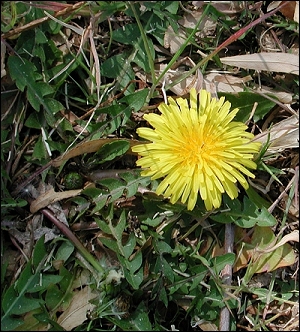

One of the most endearing—and frustrating—plants is the Common Dandelion. It's one of the earliest plants with showy flowers to appear in late winter, with its yellow blooms brightening lawns and disturbed areas. Those who value a pristine green lawn, however, may curse these cheery plants, considering them but a weed that all too often defies eradication, as it readily returns by windblown seeds on parachutes.
Beyond the esthetic—or nuisance—value, several things about this herb are of interest. As with many of us, its ancestry apparently lies in Europe. Unlike any of us, though, many groups reproduce parthenogenetically—that is, the seeds develop without fertilization by a male, making entire populations of clones. In simpler days, and still in some places, dandelions served as more than food for the eyes. The young leaves make a good, if somewhat bitter, substitute for spinach, while the roots, believed by some to have medicinal properties, may be eaten in a salad.
Dandelions, like other naturalizedorganisms, sometimes are a joy and
sometimes a real pain.

Listen to the Audio (mp3 format) as recorded by KTEP, Public Radio for the Southwest.
Contributor: Arthur H. Harris, Laboratory for Environmental Biology, Centennial Museum, University of Texas at El Paso.
Desert Diary is a joint production of the Centennial Museum and KTEP National Public Radio at the University of Texas at El Paso.

Common Dandelion in its lawn habitat. Photograph by A.H. Harris.
For enlargements of other images, click on the thumbnail pictures.